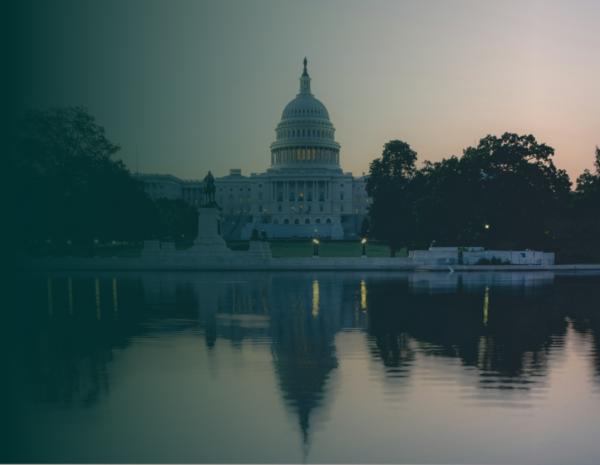Before the COVID-19 pandemic, a public health crisis was far from Americans’ minds. The idea of public health policy and a plan to deal with systematic healthcare issues, from a single strain of the cold or flu, seemed impossible.
In 2014, the ebola virus was a highly documented public health scare. Countries in Africa documented more than 11,000 deaths from the virus. However, only around 11 people were treated for the virus in the U.S.
The federal response to the COVID-19 pandemic laid bare the deficiencies of our public health response systems. Healthcare policies around disease detection, prevention, treatment, and information were minimal at best. Since 2020, policy around public health and pandemic response has become a talking point for many policymakers.
Coordination between the federal government, healthcare companies, providers, and researchers will be vital in addressing future public health crises. Without clear communication and best practices, the public is at a higher risk for contracting any virus. A disorganized response can lead to disastrous health risks.
What Is Public Health Policy?
In general, public health policy refers to the decisions, plans, and actions undertaken by governments, organizations, and institutions to achieve specific healthcare goals. As a policy topic, it encompasses a broad range of activities. Public health policies aim to promote health, prevent disease, and ensure access to healthcare. Addressing large public health issues like obesity and diabetes are relatively straightforward public health policies. However, policy responses to public health threats like COVID or seasonal flu strains are increasingly complicated.
At its core, public health policies aim to improve population health outcomes and reduce health disparities. This might involve the development of state and federal regulations, public guidelines, and programs that address various health issues. Public health policies aim to address infectious diseases, chronic conditions, environmental health risks, mental health, and access to care.
There are countless ways to approach a public health policy. But many initiatives includes the following key components:
Legislation and Regulation
Public health laws and regulations establish standards for health and safety. This might include vaccination requirements, smoking bans, and environmental protection.
Resource Allocation
A key aspect of public health policy involves distributing financial and human resources to health services, research, and public health initiatives. Effective resource allocation helps ensure efficient implementation and sustainability.
Research
Public health policies may also aim to monitor public health trends. This might involve conducting research and gathering data. These insights inform policy decisions and evaluate the effectiveness of interventions.
Education and Advocacy
Education and advocacy is yet another key goal of public health policies. Raising public awareness about health issues is key in achieving a healthy population. This might involve efforts to promote healthy behaviors or advocate for policies that support health equity and access to care.
Collaboration and Partnerships
Finally, public health policies might aim to engage various stakeholders. This might include government agencies, non-profits, healthcare providers, and the community. Collaborative efforts are key to coordinating effective efforts and leveraging resources.
The Importance of Public Health Policy In Improving Population Health
Effective public health policies are key to improving population health. These strategic actions target prevention, health promotion, and the reduction of health disparities.
Vaccination policies or best practices for healthcare screenings give populations allow populations to more effectively react to harmful viruses. Immunization programs significantly reduce the incidence of diseases like measles and polio. Sanitation regulations and testing can also combat waterborne illnesses. There’s a reason that other countries with little to no drinking water standards are known to make people sick with stomach-related illnesses.
Success in public health policy thrives on good information and education. Public health campaigns and educational programs encourage healthy behaviors and lifestyles. These factors contribute to positive determinants of health and reduce negative health outcomes. Policies that promote physical activity, balanced nutrition, and smoking cessation help prevent chronic diseases such as heart disease, diabetes, and cancer. Educational initiatives increase awareness and empower individuals to make informed health choices.
Public health policies must ensure access to affordable, high-quality healthcare services. The U.S. offers these services through health insurance, Medicare and Medicaid. Other countries offer a nationalized health care model, or single-payer system, where the government manages both insurance and healthcare operations.
Finally, reducing health inequities is another key role of healthcare policy. Factors like housing, education, employment, and income can promote or hinder population health. Community health centers, mobile clinics, and free immunization programs can help reduce the burden of disease. In doing so, they help improve health outcomes in regions with socio-economic challenges. Policies promoting affordable housing, quality education, and economic opportunities can also impact population health.
History of Public Health Policy
The history of public health policy in the United States includes significant milestones. These key events have shaped the health landscape of the nation. Key changes in public health policy include:
- The establishment of foundational public health institutions
- Legislation aimed at controlling diseases
- Policies to promote overall health and well-being
These touchstones have shaped the growth of the United States healthcare system.
Colonial Public Health Policy
In the colonial era, public health policies largely focused on quarantine laws to stop the spread of disease. The English government and, later, colonial governments, led this effort. Massachusetts passed laws that allowed local authorities to separate ill people in their homes. In 1796, Congress passed a law allowing the federal government to provide assistance to states during disease outbreaks. Boston established the nation’s first Board of Health and Health Department in 1799.
20th Century Public Health Policies
The 20th century saw the establishment of more modern public health agencies. In 1906, the Pure Food and Drug Act was passed, marking the beginning of federal regulation of food and drugs. Upton Sinclair’s famous novel The Jungle exposed disturbing practices in the production of food and meat. Public response to the novel resulted in the Meat Inspection Act.
The Public Health Service Act of 1912 expanded the federal government’s role in public health. It authorized investigations into human diseases such as tuberculosis, hookworm, malaria, and leprosy. It also authorized research on sanitation practices, including clean water and sewage disposal.
The Social Security Act of 1935 included provisions for public health funding. The Act effectively laid the groundwork for modern social welfare programs. Later, the Hill-Burton Act of 1946 provided federal funding for hospital construction. It significantly expanded healthcare infrastructure in the United States. The Centers for Disease Control and Prevention (CDC) was established in Atlanta in 1946. Then called the Communicable Disease Center, the CDC further bolstered efforts to control infectious diseases after World War II.
The Environmental Protection Agency and the Occupational Safety and Health Administration were both established in the 1970s. Their creation reflected a growing recognition of environmental and workplace health hazards. The Clean Air Act (1970) and Clean Water Act (1972) were pivotal in addressing pollution and environmental health risks.
Later, chronic diseases and health promotion for the public became the focus of public health policy. The 1964 Surgeon General’s Report on Smoking and Health laid the groundwork for anti-smoking campaigns. The Healthy People initiative, launched in 1979, set national health objectives aimed at improving population health through preventive measures.
The Affordable Care Act
Recent history around public health has focused on access and cost. Efforts to expand access to healthcare and an increased focus on health disparities led to the Affordable Care Act (ACA) in 2010. Considered a landmark legislation, the ACA aimed to reduce the number of uninsured Americans and improve access to care. It also included provisions for preventive services and public health funding.
Key Players in Public Health Policy
Several federal agencies play a role in public health decisions, regulations and coordination. These agencies collaborate to:
- Address public health challenges
- Implement policies
- Conduct research
- Provide essential services to protect and improve the health of the U.S. population
Centers for Disease Control and Prevention (CDC)
The CDC is the primary federal agency for protecting public health and safety. It focuses on controlling and preventing disease, injury, and disability. It conducts research, provides information on health issues, implements disease prevention strategies, and responds to public health emergencies.
National Institutes of Health (NIH)
The NIH is the nation’s medical research agency. It supports scientific studies aimed at improving health and preventing diseases. It is composed of 27 institutes and centers, each focused on specific health issues, including cancer, heart disease, infectious diseases, and mental health.
Food and Drug Administration (FDA)
The FDA ensures the safety, efficacy, and security of drugs, biological products, medical devices, food, and cosmetics. It regulates the development and approval of pharmaceuticals and monitors the safety of the food supply.
Health Resources and Services Administration (HRSA)
The HRSA improves access to healthcare services for people who are uninsured, isolated, or medically vulnerable. It oversees programs that provide care to geographically isolated populations, support health workforce training, and enhance the health care delivery infrastructure.
Centers for Medicare & Medicaid Services (CMS)
The CMS administers the nation’s major healthcare programs including Medicare, Medicaid, and the Children’s Health Insurance Program. It plays a critical role in ensuring access to healthcare for millions of Americans.
Examples of Public Health Policy
As mentioned, public health policies aim to address infectious diseases, chronic conditions, environmental health risks, mental health, access to care, and more. Read on to learn about examples of public health policies.
Vaccination Policies
Various public and private places require occupants and attendees to be vaccinated against certain diseases. These requirements are often driven by state-level laws and regulations. For instance, hospitals and clinics increasingly require healthcare workers to be vaccinated against Hepatitis B, Influenza, and Pertussis, among other diseases. All states require students to be vaccinated against specific diseases in order to attend school. These policies are applicable to both public and private institutions. Learn more about specific requirements at Immunize.org.
Food Labeling Regulations
The FDA ensures that foods sold in the U.S. are safe, wholesome, and properly labeled. In accordance with the Federal Food, Drug, and Cosmetic Act and the Fair Packaging and Labeling Act, the FDA provides guidance on required food label statements to manufacturers, distributors, and importers. The Nutrition Labeling and Education Act requires most foods to have nutrition labeling. Further, it sets forth specific criteria that nutrient content claims and health messages must meet. Learn more here.
Environmental Health Regulations
The EPA and CDC often collaborate on creating and implementing environmental health regulations. Environmental hazards, including chemicals, radiation, microbes, and more, can all affect human health. Environmental health laws and policies are created to regulate and safeguard our environment. This includes laws regulating blood lead level testing for children, chemical exposures, and more. Learn more here.
Drug Policy and Regulations
Every substance or drug is subject to regulation and classification. The Controlled Substances Act (CSA) classifies substances based on medical use, abuse potential, and safety or dependence risk. Drugs are then assigned to one of five “schedules,” or tiers, determined based on the aforementioned factors. Under the CSA, substances can be added, transferred between schedules, or removed from control. Various government agencies or stakeholders can initiate this process. Learn more here.
How to Influence Public Health Policy
Influencing public health policy requires technical knowledge, strategic engagement, and collaboration with key stakeholders. Both concerned constituents and policy professionals alike can get involved in the legislative process to shape public health policy. Here are some effective ways to make an impact:
- Collaboration and Partnerships: Build alliances with community groups, healthcare providers, and policymakers. Collaboration can amplify your message and help you achieve common goals.
- Policy Research and Development: Conduct and support research that informs public health policy. Gather evidence on the effectiveness of interventions and use this data to develop policy proposals. Share findings with decision-makers and stakeholders to influence policy development.
- Public Comment and Participation: Participate in public comment periods and hearings on proposed regulations. Providing testimony and submitting written comments can help ensure your voice is heard.
- Legislative Advocacy: Engage with legislators to support or oppose bills related to public health. Meet with representatives, write letters, and use advocacy networks to influence legislative decisions.
By employing these strategies, individuals and organizations can effectively influence public health policy.
Plural for Policy Tracking
Top public policy teams trust Plural for their legislative tracking needs. With Plural, you’ll:
- Access superior public policy data
- Be the first to know about new bills and changes in bill status
- Streamline your day with seamless organization features
- Harness the power of time-saving AI tools to gain insights into individual bills and the entire legislative landscape
- Keep everyone on the same page with internal collaboration and external reporting all in one place
More Public Policy Resources
Key Benefits of AI for Lobbying & Advocacy
Want to be able to explain the benefits of artificial intelligence for lobbying and advocacy? Everyone is talking about AI. And we get it, it’s not simple to understand. But as an AI-powered organization, Plural is here to help you get the most out of advancements in AI to make your job as a policy […]
2025 Legislative Committee Deadlines Calendar
Staying on top of key deadlines is manageable in one state, but if you’re tracking bills across multiple states, or nationwide, it quickly becomes overwhelming. That’s why we created the 2025 Legislative Committee Deadlines Calendar. Stay ahead of important dates and download our calendar today. Get started with Plural. Plural helps top public policy teams get […]
End of Session Report: Florida 2024 Legislative Session
The 2024 Florida legislative session saw significant activity in the realm of insurance and financial services, reflecting key themes of consumer protection, market stability, and regulatory modernization.



